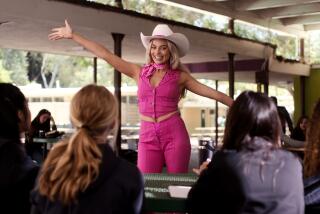Gold Standard: Oscars 2015: Why the film with the most first place votes might not win best picture

The academy’s switch to a new voting system for best picture seems to still be confusing some members.
The Oscar winner for best picture Sunday night probably won’t be the movie that the majority of voters put atop their ballots.
That’s because the Academy of Motion Picture Arts and Sciences uses a preferential voting system, one adopted six years ago when it expanded the best picture category from five movies to as many as 10. The system aims to ensure that the film with the broadest support wins — which isn’t necessarily the film that gets the most first-place votes.
“It is counterintuitive,” says Brian Cullinan, one of two partners with accounting firm PricewaterhouseCoopers who will be tallying the ballots this week after Tuesday’s voting deadline. “Often, it’s the movie listed third, fourth or fifth on a great many ballots that ends up winning. That’s hard for people to understand.”
FULL COVERAGE: Oscars 2015
Indeed, interviews with academy members suggest that many don’t understand the finer points of the system. That lack of understanding could mean the difference between front-runners “Birdman” or “Boyhood” winning the academy’s biggest prize. In a close race like this — or, say, last year’s contest between “12 Years a Slave” and “Gravity” — the ways in which voters engage or ignore the nuances of the system matter deeply.
“When people tell me, ‘I’m just voting for “American Sniper,” and that’s it,’ it infuriates me,” says an Oscar-nominated producer who requested anonymity because the academy forbids members to talk publicly about voting. “That just defeats the purpose of the system. Essentially, they’re wasting their vote.”
For the best picture Oscar, this year with eight nominees, the 6,292 voting members of the academy are asked to rank the movies in order of preference.
Ballots are collected at PricewaterhouseCoopers’ office in downtown Los Angeles, where staffers print out the ballots completed online and add them to the paper ballots.
Two PricewaterhouseCoopers accountants — Cullinan and Martha Ruiz — then sort the ballots based on members’ No. 1 votes. They eliminate the movie with the fewest first-place votes, giving those votes to each ballot’s second-ranked film. The process continues — smallest stacks eliminated, votes redistributed to the next choice down — until one movie has at least 50% plus one of the vote.
The preferential system, adopted by the academy in 2009, is similar to electoral voting methods used around the world — and in some U.S. cities including San Francisco — when there are more than two candidates. The thinking behind the system is to ensure that each ballot will have maximum influence, putting a clear premium then on the movies that voters place near the top.
Some academy members, though, still don’t have the hang of the scheme. Those who vote online, now an “overwhelming majority,” according to an academy spokeswoman, have the advantage of an intuitive click-and-drag process of ordering the movies.
But many still choose not to rank the films, voting for just their favorite movie, Cullinan says.
“Voting for one movie is OK,” he adds. “But if that movie doesn’t win, that ballot goes out.”
On the opposite end, some academy members, particularly those with a vested interest in the outcome, know enough to rank their own movie first and their closest competitor’s last. Such gamesmanship isn’t exactly new; Columbia mogul Harry Cohn, the story goes, would sit down with each academy member on his payroll and make sure they voted for the studio’s nominated films during Hollywood’s golden age.
The late Hollywood press agent and producer Walter Seltzer once recalled a 1939 meeting at which his boss, MGM publicity chief Howard Strickling, told the 60-member staff that “through the generosity of the studio” they were now all members of the motion picture academy. “There was general jubilation and thanks, then he proceeded to tell us how to vote,” Seltzer told an Associated Press reporter in 2005.
Old-school voting lives on through the academy members who still request paper ballots. Despite clear instructions to rank the best picture nominees by placing a number in the box next to the alphabetized film titles, several voters interviewed for this story didn’t know they were supposed to rank the movies at all. Or that it was possible to order the movies. Or that there were advantages inherent in listing their preferences from one to eight.
“They send instructions every year,” says one voter with a laugh, “but I guess I don’t pay attention.”
Members of the paper-ballot contingent have their own reasons for not moving online. Some like the tradition of marking a ballot by hand. Others note that the tangible nature of a paper ballot reminds them to vote. And one academy member believes voting by hand allows for more thoughtful consideration.
“With the digital thing, I worry that I’ll have a couple of drinks and then jump on my computer and vote,” says the voter. “It’s the same reason you don’t drink and tweet.”
Hangover or not, members needed to return their ballots to PricewaterhouseCoopers’ office Tuesday by 5 p.m. And it’s not like filing a tax return where a due-date postmark suffices, Ruiz notes. Procrastination results in a fair number of ballots arriving to the firm at the last minute via courier or from the stragglers themselves. Cullinan says there’s also always a number of ballots stuffed under the office door the morning after deadline.
And, no, those votes don’t count.
For the tallying this week, Cullinan and Ruiz supervise a team of nearly 30 members to come up with the final results. Accountants verify the votes and tabulate portions of the 23 other Oscar categories, all of which are determined by popular vote. (Cullinan and Ruiz personally handle the best picture vote counting.) The small-batch segments are then passed on to the two senior partners, who add the numbers and determine the winners. Only Cullinan and Ruiz know the results until the moment each envelope is opened on Oscar night.
“That’s not a hard secret to keep because it’s only for a few days,” Cullinan says. “You want to know the hard secret? Who came in second. That’s what everyone wants to know. And that’s the secret we have to keep forever.”
GRAPHIC: See how Oscar votes are counted
More to Read
Only good movies
Get the Indie Focus newsletter, Mark Olsen's weekly guide to the world of cinema.
You may occasionally receive promotional content from the Los Angeles Times.









